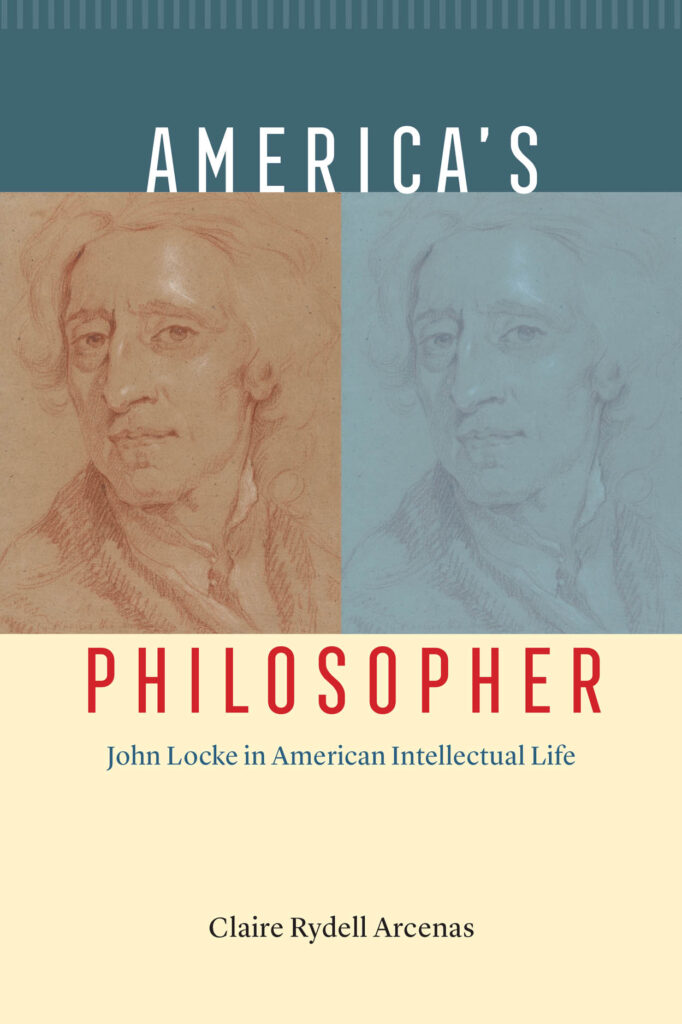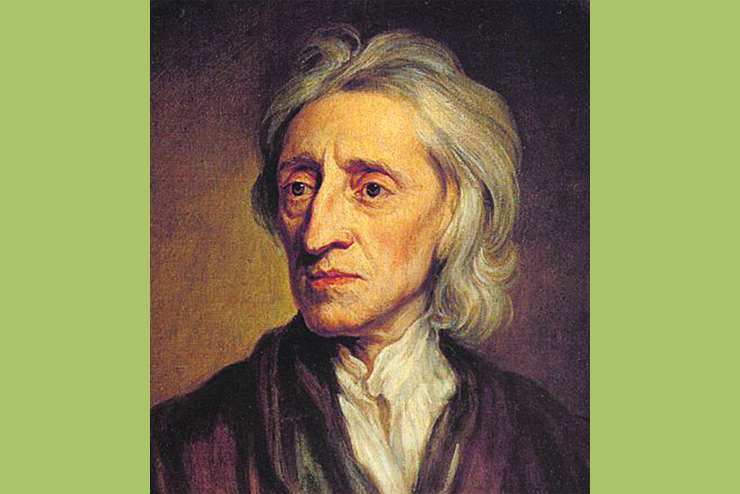
America’s Philosopher: John Locke in American Intellectual Life
by Claire Rydell Arcenas
University of Chicago Press
280 pp., $25.00
This groundbreaking work by a young historian at the University of Montana examines how three centuries of avid American readers understood the 17th-century English philosopher and polymath John Locke—and how they used him as a tool to justify the American way of life.
Unanticipated in this book full of surprises is one of Claire Arcenas’s central theses: that the Locke taught today in America’s high schools, colleges, and universities is an invention of the 20th century.
“Americans weaponized Locke, making him into an avatar of what seemed to them uniquely and quintessentially American political ideals of individual liberty, property rights, and limited government,” Arcenas writes. Locke was transformed “in the middle of the twentieth century … as a weapon of liberal democracy and capitalism in the ideological battles of the Cold War.”
Not only is this thesis wholly novel, it is also reasonably persuasive, if not wholly convincing in this short work covering a broad three-century span. One can assume that Arcenas is a young woman of the left (her epilogue makes this almost a certainty). But her carefully crafted critique of the intellectual sins of the American right in its historically bankrupt creation of a libertarian caricature of Locke, and the questionable linkage forged between Locke, Jefferson, and Lincoln by the historian Harry Jaffa, among others, deserves a receptive hearing by all students of American political thought of both the left and right.
In the course of making her argument, Arcenas also offers an impressive cultural, intellectual, and pedagogical history of Americans, including their more or less consistent moral and religious sensibilities, philosophical and literary tastes, views on child-rearing and education, and political and economic thought.
Most impressively, by closely examining course syllabi at elite colleges, notes from students and administrators, and library holdings, Arcenas reveals what American college students were being taught in courses in morality, theology, and, later, the political and social sciences. But her focus is not narrowly limited to university education. In an impressive exploration of the post-World War II goals of various Great Books programs, both in and out of universities, she details the invention of a unitary and monolithic “Western” tradition devoid of historical nuance and specificity, in which a largely invented Locke came to play an essential role.
Finally, this work also offers a primer on the late-19th and 20th centuries’ historiography of the American Founding, though less than she might have provided. Indeed, it is hard to convey the breadth and sweep of her canvass of American intellectual history, at either a learned or a more popular level.
Despite its title, one should be well aware that this work is not a close examination of John Locke’s epistemology and associated secondary literature, his educational and economic theories, or his theology, though much is impressively made of Locke’s Paraphrase and Notes on the Epistles of St. Paul. The latter work seems to adhere closely to the Reformation core teaching of sola scriptura as supported in 1619 at the Synod of Dort, whose participants had gathered in opposition to the very Arminianism which the Straussians commonly—and, according to Arcenas, mistakenly—attribute to Locke. This now-obscure work “expressed Locke’s deeply held belief that all Christians had a duty to study scripture and that scriptural study was the key to eternal salvation.” Arcenas’s consistently argued view of Locke as a possibly unique figure capable of unifying American colonists of diverse Protestant denominations, even during the nadir of Locke’s influence in the 19th century, is persuasive.
As the book progresses, her focus shifts to Locke’s political theory, which she argues declined in importance over time until recently, when it has again become of great importance. She makes an original argument that, through much of the 19th century, the work of Locke that received disproportionate attention from Americans was his Fundamental Constitutions of Carolina (1669), not his Second Treatise of Civil Government (1689). The Second Treatise is held to be a crucial Great Book of political theory today, but had become so irrelevant that it was out of print in America between 1773 and 1917.
Arcenas emphasizes that Locke’s standing in the early-to-mid-18th century resulted initially from his status as a moralist of unparalleled wisdom. This remained true during the Revolutionary War and the Founding. While Locke’s all-important philosophical text, his Essay Concerning Human Understanding, remained his best-known work, by then it still hadn’t displaced the epistemology of Descartes, as it would by the mid-18th century. Instead, men and women of the Founding era continued to “rely on his expertise in matters of childrearing and education, and celebrate his work on behalf of their Protestant religion.”
Cutting to the core of the modern narrative about Locke, Arcenas asks whether Locke was Thomas Jefferson’s chief source for the Declaration of Independence. “The answer is no,” she concludes. Arcenas is certain to offend many conservatives with that statement, including those at Hillsdale College who penned President Trump’s Advisory 1776 Commission, which promulgates this understanding of Locke.
Reviewing recent historiography, Arcenas adds insult to rightist injury. “To recite the ‘Lockean’ origins of the Declaration … is to perpetuate a powerful—and for some, politically expedient—myth,” she writes. The idea of a Lockean Founding “is a construct that was unknown to eighteenth-century Americans.” Although such a sweeping claim is impossible to prove conclusively in 40 pages of text, it is true that references to Locke in political materials, such as American state papers, proclamations, and the voluminous private correspondence of delegates, are surprisingly rare. He was more often mentioned in popular periodicals and pamphlets, and in religious, educational, and moral texts.
Arcenas convincingly shows that by the 19th century Locke’s standing had reached a low point. His political thought had come to be viewed as “an example of what Americans should avoid: namely a reliance on theory or abstract philosophy, rather than practice or experience.”
“At the dawn of the twentieth century, John Locke was the stuff of history,” Arcenas writes. Yet, two decades later, Carl Becker boldly appropriated Lockean ideas in his book Declaration of Independence (1922). This was the beginning of conservative attempts to use Locke to link the American revolutionary aspirations to the more moderate English tradition rather than the more radical French one—to say nothing of the emerging Soviet one. Locke had begun to be politicized. By the early 1930s, Locke was regularly linked to individualism, private property, and capitalism.
By World War II and the Cold War, Arcenas writes, Locke’s Second Treatise was seized on “as a ‘great book’ of Western civilization and deployed … as a bulwark against fascism, totalitarianism, and communism.”
Particularly problematic for America’s Cold War Warriors was the fact that the communists had … Marx and Das Kapital. But who and what did Americans have? … In this situation, Locke became essential.
Of critical importance in this process was the work of mid-century ‘consensus historians’ like Richard Hofstadter and Arthur Schlesinger Jr., who utilized Locke in dismissing the early 20th-century class-conflict-laden histories of Progressive historians like Charles and Mary Beard.
Arcenas notes that some on the right questioned this weaponization of Locke. She points to a 1960 letter by Leo Strauss to Willmoore Kendall, in which Strauss claims that “Locke the liberal is the chief or perhaps the sole idol in the temple of liberalism and whoever questions that idol is guilty of what the liberals themselves call ‘unorthodoxy.’”
Arcenas does not seem to appreciate, however, that today’s devoted followers of Strauss, and many putative conservatives, are among the most devout priests in the church of Locke.
Kendall, of course, is best remembered for having argued that Locke, rather than being the defender of individualism, had been, in fact, a “fierce adherent of the ‘doctrine of majority rule.’” That, in turn, had led to Kendall’s view of Locke as having denigrated the inalienable standing of individual rights. Did Strauss really agree with this view, as Arcenas argues based on the Strauss/Kendall correspondence?
In cataloguing the numerous scholars who would come to reject republicanism and reify Lockean liberalism, Arcenas seems not to notice that many are Straussian defenders of the Lockean liberal religion she argues that Strauss had done so much to denigrate. Entirely missing, too, in her account of Founding-era historiography are those historians and theorists like Samuel Huntington, who emphasized America’s Reformed Protestant origins and its British-based constitutionalism as the defining features of 18th-century American political thought and institutions.
Even if this is a work of exceptional strengths, it is not without its shortcomings, especially in its misreading of contemporary Straussians’ views of Locke. In addition, Arcenas’ claim that Locke has always stood at the center of American intellectual life doesn’t fully accord with her own evidence that his reputation was in decline for much of the 19th century.
The reader will put this book down without really understanding why Locke and Locke alone has served this particular role in American intellectual, religious, and political thought for three centuries. Yet we can and should value this book for making an impressive case for how each generation of Americans has read him with its own politically distorting lenses.

Leave a Reply